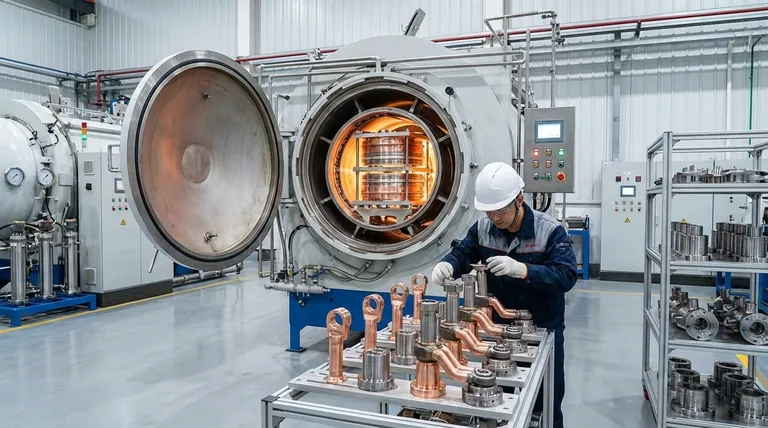In short, brazing is primarily used for joining metals in applications where precision, thermal or electrical conductivity, and the integrity of the base materials are more important than the absolute joint strength of welding. It excels in creating strong, sealed joints in complex assemblies across the aerospace, automotive, electronics, and HVAC industries.
The true value of brazing isn't just joining two pieces of metal. It's a highly controlled process chosen for its ability to create clean, strong, and often conductive joints in delicate or dissimilar materials without melting and compromising them.

When Brazing is the Superior Choice
Brazing is selected when other joining methods, particularly welding, are unsuitable due to high heat, material incompatibility, or the complexity of the assembly.
For Complex or Hard-to-Reach Joints
Brazing uses capillary action to draw the molten filler metal into the joint. This makes it ideal for assemblies with intricate shapes, a large number of joints, or joint locations with restricted access where a welding torch couldn't reach.
For Joining Dissimilar Materials
One of brazing's greatest strengths is its ability to create a strong metallurgical bond between two different types of metals, such as copper to steel. The filler metal is chosen to be compatible with both base materials, acting as a durable bridge between them.
When Preserving Material Properties is Critical
Brazing occurs at temperatures below the melting point of the base metals. This lower-temperature process minimizes the risk of thermal distortion, warping, or altering the inherent properties of the metals being joined, which is crucial for thin-walled parts or precision components.
A Look at Industry-Specific Applications
The principles of brazing make it the go-to solution for mission-critical components in a variety of high-tech fields.
In Aerospace and Automotive
Brazing is used to manufacture vital parts like engine components, sensors, and structural assemblies. High-performance filler metals, such as gold-based alloys, are used for their reliability and strength in demanding environments like aviation engines.
In HVAC and Thermal Management
The process is essential for creating leak-proof seals in HVAC systems, pipe fittings, and micro-channel heat exchangers. Copper-based brazing materials are widely used here for their excellent thermal conductivity and corrosion resistance.
In Electronics and Medical Devices
In the electronics industry, brazing joins electromechanical components and parts for electric vacuum devices. Its precision and low-heat nature are perfect for delicate sensors and medical instruments where overheating would cause catastrophic failure.
Understanding the Trade-offs
While powerful, brazing is not a universal solution. Understanding its limitations is key to using it effectively.
Lower Strength Than Welding
A brazed joint is typically not as strong as a properly welded joint. The strength of the braze is dependent on the filler metal, not the fused base metals, making it unsuitable for applications requiring the absolute highest tensile strength.
Requirement for Tight Tolerances and Cleanliness
For capillary action to work correctly, the gap between the two parts being joined must be precisely controlled. Furthermore, the surfaces must be exceptionally clean of oxides and contaminants for the filler metal to adhere properly.
Heat-Affected Zone (HAZ)
Although the process uses lower heat than welding, it still creates a heat-affected zone around the joint. This can slightly alter the mechanical properties (e.g., temper) of the base metals, a factor that must be accounted for in engineering design.
Making the Right Choice for Your Goal
Select your joining process based on the most critical requirement of the final assembly.
- If your primary focus is joining dissimilar metals or delicate components: Brazing is the superior choice due to its lower heat input and material versatility.
- If your primary focus is creating leak-proof, conductive joints: Brazing with copper-based fillers is the industry standard for thermal and electrical applications.
- If your primary focus is maximum joint strength above all else: Welding should be your first consideration, as it fuses the base metals directly.
Choosing the right manufacturing process is about aligning its specific advantages with your project's unique demands.
Summary Table:
| Application Area | Key Use Cases | Key Benefit |
|---|---|---|
| Aerospace & Automotive | Engine components, sensors, structural assemblies | High reliability in demanding environments |
| HVAC & Thermal Management | Heat exchangers, pipe fittings, leak-proof seals | Excellent thermal conductivity & corrosion resistance |
| Electronics & Medical Devices | Electromechanical components, sensors, instruments | Precision joining without overheating delicate parts |
| General Manufacturing | Joining dissimilar metals (e.g., copper to steel), complex shapes | Preserves base material properties with lower heat input |
Need precision brazing solutions for your lab or production line?
KINTEK specializes in high-performance brazing alloys and lab equipment for aerospace, automotive, electronics, and HVAC applications. Our materials ensure strong, conductive, and leak-proof joints in even the most complex assemblies.
Contact our experts today to discuss how our brazing solutions can enhance your manufacturing process!
Visual Guide

Related Products
- Vacuum Heat Treat Sintering Brazing Furnace
- Molybdenum Vacuum Heat Treat Furnace
- 1400℃ Laboratory Quartz Tube Furnace with Alumina Tube Tubular Furnace
- Laboratory Muffle Oven Furnace Bottom Lifting Muffle Furnace
- High Pressure Laboratory Vacuum Tube Furnace Quartz Tubular Furnace
People Also Ask
- What is the difference between welding and vacuum brazing? Choose the Right Joining Method for Your Project
- What is the cost of a vacuum brazing furnace? A guide to key factors and investment strategy
- What is brazing in heat treatment? Achieve Superior Joint Quality and Efficiency
- What is the process of a vacuum furnace? Achieve Purity and Precision in High-Temp Processing
- What are vacuum furnaces used for? Unlock Ultimate Material Purity and Performance



















